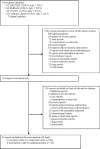Effect of Fructose on Established Lipid Targets: A Systematic Review and Meta-Analysis of Controlled Feeding Trials
- PMID: 26358358
- PMCID: PMC4599489
- DOI: 10.1161/JAHA.114.001700
Effect of Fructose on Established Lipid Targets: A Systematic Review and Meta-Analysis of Controlled Feeding Trials
Abstract
Background: Debate over the role of fructose in mediating cardiovascular risk remains active. To update the evidence on the effect of fructose on established therapeutic lipid targets for cardiovascular disease (low-density lipoprotein cholesterol [LDL]-C, apolipoprotein B, non-high-density lipoprotein cholesterol [HDL-C]), and metabolic syndrome (triglycerides and HDL-C), we conducted a systematic review and meta-analysis of controlled feeding trials.
Methods and results: MEDLINE, EMBASE, CINHAL, and the Cochrane Library were searched through July 7, 2015 for controlled feeding trials with follow-up ≥7 days, which investigated the effect of oral fructose compared to a control carbohydrate on lipids (LDL-C, apolipoprotein B, non-HDL-C, triglycerides, and HDL-C) in participants of all health backgrounds. Two independent reviewers extracted relevant data. Data were pooled using random effects models and expressed as mean difference with 95% CI. Interstudy heterogeneity was assessed (Cochran Q statistic) and quantified (I(2) statistic). Eligibility criteria were met by 51 isocaloric trials (n=943), in which fructose was provided in isocaloric exchange for other carbohydrates, and 8 hypercaloric trials (n=125), in which fructose supplemented control diets with excess calories compared to the control diets alone without the excess calories. Fructose had no effect on LDL-C, non-HDL-C, apolipoprotein B, triglycerides, or HDL-C in isocaloric trials. However, in hypercaloric trials, fructose increased apolipoprotein B (n=2 trials; mean difference = 0.18 mmol/L; 95% CI: 0.05, 0.30; P=0.005) and triglycerides (n=8 trials; mean difference = 0.26 mmol/L; 95% CI: 0.11, 0.41; P<0.001). The study is limited by small sample sizes, limited follow-up, and low quality scores of the included trials.
Conclusions: Pooled analyses showed that fructose only had an adverse effect on established lipid targets when added to existing diets so as to provide excess calories (+21% to 35% energy). When isocalorically exchanged for other carbohydrates, fructose had no adverse effects on blood lipids. More trials that are larger, longer, and higher quality are required.
Clinical trials registration: URL: https://www.clinicaltrials.gov/. Unique Identifier: NCT01363791.
Keywords: lipids; meta‐analysis; nutrition.
© 2015 The Authors. Published on behalf of the American Heart Association, Inc., by Wiley Blackwell.
Figures








References
-
- Lustig RH. Fructose: metabolic, hedonic, and societal parallels with ethanol. J Am Diet Assoc. 2010;110:1307–1321. - PubMed
-
- Goran MI, Ulijaszek SJ, Ventura EE. High fructose corn syrup and diabetes prevalence: a global perspective. Glob Public Health. 2013;8:55–64. - PubMed
-
- Miller M, Stone NJ, Ballantyne C, Bittner V, Criqui MH, Ginsberg HN, Goldberg AC, Howard WJ, Jacobson MS, Kris-Etherton PM, Lennie TA, Levi M, Mazzone T, Pennathur S American Heart Association Clinical Lipidology T, Prevention Committee of the Council on Nutrition PA, Metabolism, Council on Arteriosclerosis T, Vascular B, Council on Cardiovascular N, Council on the Kidney in Cardiovascular Disease. Triglycerides and cardiovascular disease: a scientific statement from the American Heart Association. Circulation. 2011;123:2292–2333. - PubMed
-
- Canadian Diabetes Association Clinical Practice Guidelines Expert Committee. Canadian Diabetes Association 2013 clinical practice guidelines for the prevention and management of diabetes in Canada. Can J Diabetes. 2013;37(suppl 1):S1–S212. - PubMed
-
- Livesey G, Taylor R. Fructose consumption and consequences for glycation, plasma triacylglycerol, and body weight: meta-analyses and meta-regression models of intervention studies. Am J Clin Nutr. 2008;88:1419–1437. - PubMed
Publication types
MeSH terms
Substances
Associated data
Grants and funding
LinkOut - more resources
Full Text Sources
Medical
Miscellaneous

